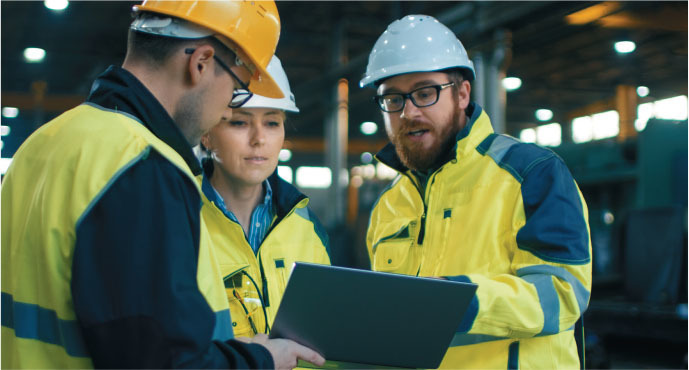


Three of MHI’s Industry Groups recently were appointed ambassadors to a federal program geared toward the safety of hoists, cranes and monorails. Crane Manufacturers Association of America (CMAA), Hoist Manufacturers Institute (HMI) and the Monorail Manufacturers Association (MMA) gained ambassador status with the U.S. Occupational Safety and Health Administration’s (OSHA’s) Crane, Hoist and Monorail Alliance (CHM). The three groups, which make up OSHA’s CHM Alliance as well as MHI’s Overhead Alliance, will promote cooperative programs with the federal agency, raising awareness of OSHA’s initiatives, outreach, communication, training and education, and also providing information, guidance and access to training resources that help protect the health and safety of workers using hoists, cranes and monorails.
“We are grateful to work together with OSHA to ensure the safe operation of our equipment,” said Karen Norheim, president of CMAA and president/COO of MHI member American Crane and Equipment Corp. “This industry government partnership helps to promote awareness on best practices and training as well as OSHA initiatives and outreach. Together we amplify the efforts for the safe operation of overhead lifting solutions.”
The guide, which will supplement the fact and tip sheets the Alliance already provides, is designed to address topics not covered by existing OSHA regulations, as well as common questions about complex regulations that need clarification, said Beilfuss.

“For example, two questions we frequently hear are: When are load tests required? How often should they be completed? In the best practices guide, we define what a load test is and the requirements based on multiple industry standards—OSHA, CMAA, ASME, ANSI,” he said. “We then list the industry’s best practices as guidelines to follow when conducting load tests.”
The CHM Alliance is currently in the document review phase with OSHA officials and is targeting publication for later this year, Beilfuss said. The Overhead Lifting Best Practices Guide will be released on MHI’s website.
Becoming an OSHA ambassador is just one of the ways CMAA members are keeping the crane industry on top of the ever-changing supply chain. This MHI Industry Group has also been developing new specifications and preparing for the Overhead Alliance’s upcoming safety conference.
“The CMAA’s mission is to deliver technical specifications and resources that promote safety in the design, operation and maintenance of overhead cranes,” said Norheim. “Our vision is to be the most trusted knowledge resource for overhead cranes.”
CMAA is working to complete its review and update of the group’s specifications publication, conducted every five years, said Bob Kotel, chief design engineer at MHI member G.W. Becker Inc. and CMAA’s vice president—engineering.
“There are quite a few changes to Specification No. 70 for multiple girder cranes and Specification No. 74 for single girder cranes, specifically in the mechanical, structural and electrical sections,” Kotel said. “The revisions keep the specifications in sync with the ASME B30 standards for crane safety, the National Electrical Code and other standards dealing with overhead material handling.”
In addition, CMAA is currently developing two new specs due to the changing requirements within the industry, he said. The first is Specification No. 80—Below-the-Hook Lifting Device Operator’s Manual. The PDF version is available now on the CMAA website, and the group is now reviewing the hard copy to have copies available for sale. The second new spec is Specification 76, which will be for jib cranes and is planned for release in 2021.
CMAA also contributes to a blog as part of the Overhead Alliance, which serves as a marketing partnership for CMAA, HMI and MMA. The Overhead Lifting Safety Blog (overheadlifting.org) launched in 2019 serves as an avenue to teach and share resources about overhead lifting, Norheim said.
“Overhead lifting solutions improve efficiency, productivity and safety and reduce environmental impact,” she said. “New technology has made overhead lifting solutions easier and more productive to use than ever before. Advancements include enhanced-precision speed controls, wireless operation and predictive maintenance, which results in longer lasting equipment.”
Also geared toward online instructional content is the fourth annual Overhead Lifting Safety Conference that will be held in a weekly webinar format starting this October, “following the remarkable success of last year’s sessions,” said Scott Salisbury, general manager at MHI member Bradley Lifting Corp. The conference is hosted by the Overhead Alliance and is designed for safety, plant operations and plant maintenance personnel responsible for overhead lifting cranes and hoists. The series will include presentations and Q&A from industry experts and an OSHA representative. Each webinar is scheduled to run for one hour every Thursday from Oct. 28 to Nov. 18.
“Previous and prospective attendees should be excited to learn that one of the highlights for this year will be a safety program panel discussion session,” Salisbury said. “The sessions will include presentations on safety program examples from top-performing companies, followed by a roundtable discussion on topics related to implementing or fine-tuning a safety program within their own company.”
The conference is regularly priced at $300, but the first 50 registrants will receive a $50 discount.
To learn more about the Overhead Alliance, visit mhi.org/solutions/overhead-alliance.
 MHI Solutions Improving Supply Chain Performance
MHI Solutions Improving Supply Chain Performance